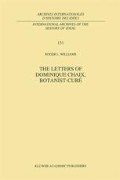Abstract
Dominique Chaix was born on 8 June 1730 at a grange or farm call Berthaud in an alpine region still remote today. The property may be found northwest of Gap, just above Rabou, at La Crotte along the Torrente de La Crotte, one of the several tumbling tributaries of the Petit Buëch. The Chaix family, originally from the commune of Chaudun, not only farmed the Berthaud property, but also a higher farm called La Grangette under a great crag known as the Pic de Bure. Sheep-raising accounted for more than three-quarters of their agricultural income.1
Access this chapter
Tax calculation will be finalised at checkout
Purchases are for personal use only
Preview
Unable to display preview. Download preview PDF.
Reference
Villars, “Notice historique sur Dominique Chaix, botaniste.” Bull. Soc. Etudes Hautes-Alpes 3, no. 1 (1884): 297–298.
Charles Charronnet, Monastères de Durbon et de Berthaud (Diocèse de Gap). Documents historiques (Grenoble: Alphonse Merle, 1863), pp. 47–49, 64, 69–70; Paul Guillaume, Clergé ancien et modern du diocèse de Gap. Abbés, prieurs, curés, vicaires, chapelains… de toutes les paroisses du diocèse actuel (Gap: Jean & Peyrot, 1909), p. 184.
For the bishops of Gap in the 18th century, see Timothy Tackett, Priest & Parish in Eighteenth-Century France (Princeton: Princeton University Press, 1977), pp. 27–31.
Villars, “Notice historique sur Dominique Chaix,” pp. 298–300, 315–316; Guillaume, Clergé ancien et moderne du diocèse de Gap, p. 34, 98; Adolphe Rochas, Biographie du Dauphiné (Paris: Charavay, 18561860), 1: 194; Félix Allemand, Dictionnaire biographique des Hautes-Alpes (Gap: Alpine, 1911), pp. 141143. Allemand is not reliable in every detail.
Pietro Andrea Mattioli (1500–1577), a physician of Siena, who published commentaries on Dioscorides that were translated into many languages.
B. Joyeux and A. Dejarnac, “Le Médecin Dominique Villars (1745–1814).” Bull. Soc. Etudes Hautes-Alpes Année 1969: 122, 126–127.
Villars, Hist. PI. Dauph. 1:viii-x (1786).
Dr. Victor Bally, Notice historique sur la vie et les travaux du docteur Villars, naturaliste, correspondant de l’Institut (Grenoble: Imprimerie de Maisonville, 1858), pp. 2–8.
Georges de Manteyer, “Les Origines de Dominique Villars, le botaniste (1555–1814).” Bull. Soc. Etudes Hautes-Alpes, ser. 4, 40 (1921): 129–137.
Villars, Hist. PI. Dauph. 1: x-xiv (1786). The garden was evidently owned by Dr. Joseph-François Prunelle de Lière, a physician who did not practice medicine. See Rochas, Biographie du Dauphiné 2: 308n.
John Briquet, “Jean-Jacques Rousseau, botaniste.” Bull. Inst. Natl. genevois 41 (1914): 134–136.
See Sir Gavin de Beer, “Jean-Jacques Rousseau botanist.” Ann. Sci. 10, no. 3 (1954): 189–208; Jean Starbobinski, “Rousseau and Buffon.” Jean-Jacques Rousseau, Transparency and Obstruction (Chicago: University of Chicago Press, 1988), pp. 235–238.
Marc-Antoine-Louis Claret de Fleurieu de La Tourrette (1729–1793), judge at the fiscal court of Lyon until 1771, permanent secretary of the Académie in Lyon from 1767 to 1793. The Abbé Jean-François Rozier (1734–1793), director of the Ecole vétérinaire de Lyon and in charge of its botanical garden. See Dr. Antoine Magnin, Les Botanistes Lyonnais I. Claret de La Tourrett (Lyon: H. Georg, 1885), pp. 6–10, 214–216.
Rousseau, Rêveries du promeneur solitaire (Paris: A. Desrez, 1837), 1: 441. What little we know of Pierre Liottard depends upon a memorial written by a notable legal expert in Grenoble who took an interest in botanic gardens: Jacques Berriat-Saint-Prix, “Notice historique sur Pierre Liottard, botaniste, lue à 1”Académie de Grenoble les 6 et 17 août 1799.“ Magasin encyclopédique, ou Journal des sciences, des lettres et des arts no. 8 (1 Fructidor Year VI): 504–510; and upon Villars, Notice sur la vie et les talens de Pierre Liottard, excellent botaniste, mort à Grenoble, le 29 Germinal l’an 4me. Grenoble: Emile Baratier, 1887. Liottard was born in Saint-Egrève, a village near Grenoble, in 1729, into a poor working family. He received the most rudimentary instruction and was destined to be a weaver. Toward the age of twenty, he sought to escape that fate by enlisting in the army; but he was wounded in 1756 during the French assault on Port Mahon and forced to return to his vocation. Thereafter, he found employment with an uncle, Claude Liottard, an herb merchant. Their trips to gather plants awoke his taste for botany, and he learned its principles from Dr. Clappier. By the time Rousseau visited Grenoble, Liottard had developed a reputation as a botanical fanatic.
Auguste Ducoin, Trois mois de la vie de Jean-Jacques Rousseau. Juillet-Septembre 1768 (Paris: Dentu, 1852), pp. 8, 31, 36–38, 60–63; Ernest Jovy, “Un Document inédit sur le séjour de Jean-Jacques Rousseau à Grenoble en 1768.” Soc. sci. arts Vitry-le-François 19 (1899): 117–120; Rochas, Biographie du Dauphiné 1: 172–174.
Rousseau to Claret de La Tourrette, Monquin, 26 January 1770. Correspondance complète (Geneva: Voltaire Foundation, 1965–1984) 37: 211–212. Also see Gustave Vallier, Lettres inédites de Jean-Jacques Rousseau (Grenoble: Prudhomme, 1863), pp. 5–12.
Ducoin, Trois mois de la vie de Jean-Jacques Rousseau p. 66.
Bally, Notice historique sur la vie et les travaux du docteur Villars, pp. 9–11; Joyeux and Dejarnac, “Le Médecin Dominique Villars,” p. 129; Villars, Hist. Pl. Dauph. 1: xiv-xv (1786); Albin Gras, “Historiques des institutions médicales de la ville de Grenoble.” Bulletin de la Société de statistique, des sciences naturelles et des arts industriels du Département de l’Isère sér. 1, 3 (1844): 264–265.
Author information
Authors and Affiliations
Rights and permissions
Copyright information
© 1997 Springer Science+Business Media Dordrecht
About this chapter
Cite this chapter
Williams, R.L. (1997). The Setting. In: The Letters of Dominique Chaix, Botanist-Curé. Archives Internationales D’Histoire Des Idées International Archives of the History of Ideas, vol 151. Springer, Dordrecht. https://doi.org/10.1007/978-94-011-5490-1_1
Download citation
DOI: https://doi.org/10.1007/978-94-011-5490-1_1
Publisher Name: Springer, Dordrecht
Print ISBN: 978-94-010-6310-4
Online ISBN: 978-94-011-5490-1
eBook Packages: Springer Book Archive

